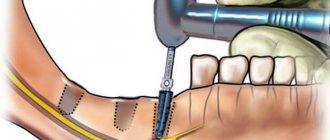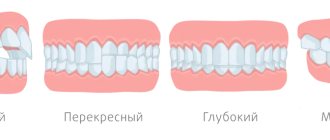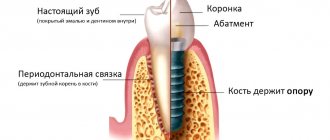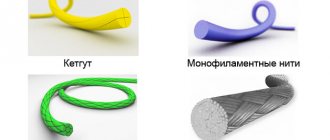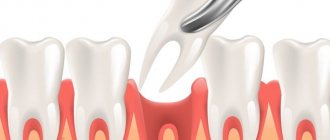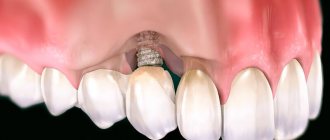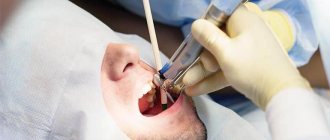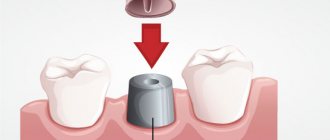Periodontitis and periodontal disease are diseases of periodontal tissues that cause resorption of the jaw bone tissue, loosening and loss of teeth. The first is of an infectious nature and is accompanied by an inflammatory process. The reason for the second is systemic disturbances in the functioning of the body. Lost teeth in such cases are restored through classical prosthetics or implantation. The latter is the most effective. Titanium analogues of tooth roots provide full load on the bone, prevent atrophy and bacterial processes, and last a lifetime. Before installing implants, the patient must undergo comprehensive treatment aimed at relieving the disease and bone grafting to increase the missing tissue volume.
Is it possible to place implants with periodontal disease?
Periodontal disease is a chronic disease of periodontal tissues in which bone resorption occurs around the tooth roots. It occurs extremely rarely - in 1-7% of cases. It differs from periodontitis in the absence of an inflammatory process and its generalized nature (the problem concerns the entire jaw, and not a separate area).
Causes of the disease:
- deterioration of metabolism, which negatively affects the blood supply to soft tissues;
- osteopenia - pathologically low density or mass of bone structures, leading to resorption;
- dysfunction of the nervous and immune systems;
- atherosclerosis;
- diabetes;
- genetic predisposition;
- mechanical damage, dental trauma.
Stages of periodontal disease:
- Mild - asymptomatic, with only occasional itching in the gums, discomfort while eating, and occasional bad breath. Determined by a panoramic radiograph - shows bone resorption of less than ⅓.
- Medium - manifested by frequent itching, exposure of the necks of the teeth. The image reveals bone resorption up to half of the tooth root.
- Severe - there is loosening and protrusion of teeth, an abundance of plaque and deposits, bad breath, a reaction to thermal irritants and solid foods. The x-ray shows resorption at the level of ⅔ of the tooth.
Implantation for periodontal disease is a reliable way to restore lost teeth and save the remaining ones. Due to the absence of an inflammatory process in this disease, there is no need for preliminary therapy. Before implanting titanium rods, the main task is to identify and eliminate the cause of jawbone recession and remove teeth that cannot be saved.
Obstacles to implantation may include:
- the impossibility of detecting and treating diseases that cause bone loss - implants are placed only if you are confident that the required volume can be maintained.
- hereditary factors or diabetes mellitus are involved in the development of periodontal disease;
- health problems that increase the risk of structural failure;
- poor oral hygiene, bad habits.
Basal implantation with immediate load is the best option
With basal implantation, titanium roots are installed through the alveolar process into the basal region and zygomatic bone, including the cortical plate. These layers of the jaw have a high density and are not subject to atrophy.
For implantation, one-piece implants with a non-removable abutment and a compression type of thread are used. These properties provide reliable initial stability and allow immediate prosthetic restoration.
What technologies are used
BASAL COMPLEX (basal complex) is a one-stage implantation method, which is indicated for acute bone deficiency. 8-12 implants are installed on one row of teeth, some of which are implanted at an angle. The inclined position makes it possible to improve the contact of the implant with the bone, select the optimal areas for implantation, and bypass blood vessels and nerve endings.
Who is indicated and who is contraindicated
Indications for basal implantation:
- absence of 3 or more teeth;
- complete edentia;
- bone atrophy;
- the need for dental reconstruction in case of periodontal diseases;
- impossibility of performing bone grafting.
Contraindications:
- period of pregnancy and lactation;
- decompensated diabetes mellitus;
- disturbances in the functioning of the cardiovascular, circulatory, nervous and immune systems;
- malignant tumors;
- inflammatory processes in the oral cavity;
- hypertonicity of the masticatory muscles;
- infectious diseases.
Preparatory stage
- Sanitation of the oral cavity . Treatment of caries, removal of unusable teeth, and professional cleaning of deposits are carried out.
- Therapeutic treatment of periodontal tissue involves the application of bandages, applications and ointments.
- Procedures for electrophoresis, ultraviolet irradiation or plasma lifting .
- Taking multivitamins, local immunostimulants, hemostatic drugs .
- Splinting or grinding of mobile teeth (according to indications).
- Computed tomography, x-ray examination to assess the condition of bone tissue, determine the area for implantation.
- Three-dimensional modeling , determination of the angle of inclination.
- Selection of implants.
How to place basal implants
No gum resection is required to install basal implants. The surgeon makes a small puncture in the gum and screws the structure into the bone. To maintain accuracy when placing implants, individual templates in the form of a mouth guard with holes are used.
Choosing Dental Implants
Main manufacturers of basal titanium rods:
- Oneway Biomed and Ihde Dental;
- Nobel Biocare;
- Trate AG (ROOTT);
- Noris Medical;
- BOI Ihde Dental;
- TOI Biomed;
- PEEK-Optima;
- Osstem.
Is it possible to place implants with periodontitis?
Periodontitis is a common inflammatory disease of periodontal tissue, accompanied by resorption of the jaw bone. It is the main cause of early loss of permanent teeth. It differs from periodontal disease in its infectious nature.
Develops due to:
- poor oral hygiene;
- advanced caries, gingivitis;
- improper prosthetics;
- malfunctions of the digestive system.
It occurs in acute or chronic form. The first is characterized by:
- accumulation of plaque on the enamel surface;
- bleeding from the gums;
- pain, itching;
- purulent exudate in gum pockets;
- tooth mobility;
- bad breath.
In chronic cases, there is bleeding and instability of dental units.
There are three stages of the disease:
- Mild - the depth of periodontal pockets is less than 4 mm, bone resorption in the area of the interradicular septum is up to ⅓ of the root length, tooth mobility is grade I-II.
- Medium - pockets up to 6 mm, loss of bone mass by ½ of the root length, degree I-II instability.
- Severe - the size of the pockets is more than 6 mm, the resorption of the partitions is more than half the length of the roots, degree III mobility.
Periodontitis and implantation are quite compatible. Moreover, this is the only effective method of restoring lost teeth, but only if the source of infection is stopped. Therefore, before the procedure, complex treatment is carried out, restoration of periodontal ligaments, and strengthening of soft tissues. In patients with a chronic form of the disease of mild and moderate stages, only the missing units of the dentition are restored. In severe and acute cases, all teeth are removed and implants are placed.
Contraindications:
- the inflammatory process has not been eliminated;
- complete atrophy of jaw tissue due to the impossibility of bone grafting;
- general diseases that are included in the list of restrictions for implantation;
- poor oral hygiene, bad habits.
Materials
Dental implants for periodontal disease can be made of titanium alloy - these are the models that are offered to patients in most cases. However, with inflammation or atrophy of the periodontium, the likelihood of allergic reactions increases, and even titanium sometimes causes them.
Today, implants made of zirconium dioxide are increasingly used in dental practice - this is the development of European scientists. They are made in Switzerland, Germany and the USA.
Important!
Zirconium roots are absolutely hypoallergenic.
Titanium implants are not placed in cases of hypersensitivity to certain metals and alloys, multiple allergies, or hay fever. They are used with caution in patients with psoriasis.
Doctor's advice - it will take a lot of time to prepare for implantation
The patient should be prepared for the fact that treatment and preparation for implantation will take a long time - on average 1 year. These are necessary measures, since regardless of the causes of the disease, when installing implants, the doctor is faced with resorption of the jaw bone and unsatisfactory condition of the gums. Osteoplasty in conditions of inflammation is also not performed. First, the source of infection is stopped, and then bone tissue is augmented.
Levin Dmitry Valerievich
Chief physician, Ph.D.
Implantation is the only effective way
Implants are screwed into the bone and do not require periodontal ligaments to secure them. The surface of the necks of special implants is resistant to the accumulation of microbes. Thus, dental implantation is the only effective way to restore teeth in conditions of periodontitis , but only if the disease is stopped . The patient gets rid of chronic periodontitis, the periodontal ligaments are restored, and the soft tissues are strengthened, remodeled and, with good hygiene, serve as a natural barrier to the penetration of infection into the bone.
The integrity of the dentition and proper distribution of the chewing load contributes to:
- stimulating blood circulation and normalizing nutrition of bone and gum cells,
- stops uneven distribution of chewing load and overload of teeth,
- prevents changes in bite and tooth mobility.
Implants should not be installed near teeth affected by periodontitis. If the remaining teeth, as the main source of “infection,” are left without complex therapy, then the development of infection will lead to an attack by pathogenic microflora on nearby implants and the soft tissue around them, and this will lead to complications and even rejection. Therefore, first of all, before implantation, you need to undergo a comprehensive course of periodontitis treatment and reduce the risks.
BE CAREFUL! Some unscrupulous and inexperienced doctors convince patients to place implants next to adjacent teeth affected by periodontitis, without informing them of the danger and essentially hoping for a “miracle.” Under no circumstances do this without simultaneous treatment and bringing periodontitis into a state of stable remission. Plus the realization that careful hygiene with this approach is very important in the future.
ON A NOTE! According to the American Association of Periodontists www.perio.org, the average age of a patient with periodontitis is 40+, 70% have implants in the oral cavity with developing complications.
With the development of microbiology and nanomaterials, drugs have been developed that not only stably stop the disease for many years, but also make it possible to restore the consequences of complex forms of periodontitis up to 80% in 1 year. Today, advanced dentistry has effective tools for preserving teeth. Smile recovery periodontal complexes are aimed initially at eliminating the environment for the development of the disease, and then enriching the affected areas with active growth factors to create a favorable environment for the natural regeneration of the patient’s cells and tissues.
Deep cleaning of periodontal pockets and 1-2 procedures will not stop the progression of the disease. Periodontitis is a multifaceted disease with an individual pathogenic flora for each patient and it must be treated accordingly, using a set of antibacterial and restorative measures, selected individually after a thorough study of microflora culture from periodontal pockets, drawing up a periodontogram, analyzing the state of bone tissue using computed tomography and additional blood tests.
Do you want to save your teeth and stop the disease? Smile recovery periodontal complexes that really work.
find your solution
Implantation options depending on the severity of the disease
| Partial implantation (remaining teeth are retained ) | Full implantation (all teeth are removed) | |
| Depth of periodontal pockets | up to 8 mm | more than 8 mm |
| Nature of inflammation | localized | generalized (affects the entire jaw) |
| Mobility of dental row units | I-II degrees | III degree remaining units |
| Bone quality | Type II-III (cortical layer thickness 3-5 mm, spongy layer with a developed network of thin trabeculae) | severe atrophy of the jaw bone |
| Condition of remaining teeth | satisfactory | accumulation of dental plaque |
| Tissue healing ability | high or medium | low |
Requirements for implants
The selection of titanium rods is carried out at the preparatory stage, taking into account a number of requirements:
- high primary stability;
- a special surface that improves fusion with jaw tissue and is resistant to the accumulation of microbes.
In the world, only three manufacturers produce implants for installation in periodontitis and periodontal disease, the leader of which is Nobel Biocare (Switzerland). It is these systems that our clinic works with, which allows us to guarantee a successful result.
Implantation is carried out after stopping foci of infection, complex treatment and rehabilitation, with rods with the following properties:
- the tight fit of the abutment to the gum protects the underlying bone and guarantees long-term stability and health of the gingival structures;
- Smooth anodized coating created using nanoparticles improves soft tissue attachment;
- the single orthopedic platform On1 allows you to preserve the structure of connective tissues and avoid surgery during further prosthetics.
What are the features and advantages of the procedure?
- Movable teeth are removed, rather than splinted, bonded to healthy ones. This makes it possible to protect healthy teeth from additional stress.
- During installation, high primary stabilization of the implanted artificial root is achieved, which makes immediate prosthetics possible.
- Chewing loads from the first days after surgery activate blood circulation and bone regeneration.
- Implantation surgery for periodontal diseases can be carried out even with severe atrophy of bone tissue.
- Immediately after the procedure (1-7 days), a fixed prosthesis is put on.
Considering how difficult periodontitis of even one tooth is amenable to conservative treatment, and how quickly it spreads, affecting neighboring ones, many dentists recommend immediately opting for surgical treatment. Presence of an implant:
- does not support further inflammatory process;
- promotes healthy bone tissue, preventing its resorption;
- allows you to enjoy an aesthetic smile and adhere to your normal diet.
It is these advantages that have made implantation for periodontal diseases one of the most effective and popular methods of surgical treatment.
Implantation methods
Tooth restoration for periodontal tissue diseases is carried out using two methods:
- One-stage with immediate loading is a minimally invasive express technique in which a temporary prosthesis is fixed 2-3 days after implantation of special titanium roots into the deep layers of the bone.
- Classic with delayed loading - consists of two stages: implantation (carried out using the patchwork method by dissecting the gingival tissue followed by suturing) and prosthetics (the permanent prosthesis is attached after 4-6 months - after complete engraftment of the structure).
The one-step method has a number of disadvantages:
- dental implantation for periodontitis or periodontal disease using an express protocol is experimental, there are no long-term clinical results, which increases risks;
- there is no guarantee of reliable fixation of the rods in loose bone of low height after periodontal tissue disease;
- After rejection, the likelihood of successful bone grafting is minimal.
According to statistics, the probability of rejection of implants installed using the one-stage method due to periodontal tissue diseases is about 40% . If it occurs, it has serious consequences - the process of exfoliation of the weakened bone is activated. Therefore, we abandoned this protocol in favor of the classic one; the risks for the patient are too high.
Are alternatives possible?
In case of inflammation of periodontal tissue, two-stage implantation is not recommended due to the fact that implants with this approach are installed in the central part of the bone tissue, which is most susceptible to inflammatory processes. This means there is a high risk of developing complications and rejection of structures. It will also not be possible to install a dental bridge - there is a high probability that the teeth remaining in the oral cavity will begin to loosen after some time. This will lead to mobility of the bridge and breakdown of the entire system.
In case of partial edentia and at the same time mobile teeth that are in a relatively healthy condition, the problem can be solved by installing a clasp denture. It has a metal base, which will allow you to secure the position of loose teeth and at the same time provide prosthetics for lost ones.
If there is acute inflammation that extends to most or all of the dentition, you may consider installing a removable soft plastic denture. At least for the duration of the acute stage of inflammation.
1 According to the World Health Organization (WHO). 2 According to official clinical trial data from Oneway Biomed.
Implant installation - stages
Treatment of periodontal diseases
The main task of implantation in conditions of periodontitis or periodontal disease is to stop the disease, otherwise there is a high probability of rejection. Here it will not be possible to get by with cleaning periodontal pockets; this will not stop the course of the pathological process. Drugs can help achieve remission. They are selected individually after examination:
- examination of the contents of periodontal pockets;
- periodontogram;
- blood tests;
- CT scan of the dentofacial apparatus.
The medication course takes up to 1 year. At the same time, measures are taken to preserve the remaining teeth, if possible. Periodontal complexes are used aimed at creating favorable conditions for the natural regeneration of jaw structures.
Bone tissue augmentation
Osteoplasty is a surgical operation aimed at increasing the height and volume of the jaw bone to create reliable support for dental implants. Performed before implantation. If you place titanium rods in atrophied tissues, this is fraught with their exposure, overload and rejection. The use of single-stage rods is risky due to the risk of damage to blood vessels and nerve fibers.
The method of extension is selected based on the clinical picture. Our Center uses the following methods:
- Sinus lifting is prescribed for the upper jaw when there is a risk of injury to the maxillary sinus with classic implants. It involves creating access in the bone to the bottom of the sinus for subsequent lifting and filling the resulting space with a graft. It is performed in an open or closed manner, depending on how many millimeters it is necessary to increase the height of the alveolar process.
- The technique of directed regeneration, the use of barrier membranes are indicated for increasing the bone of the upper or lower jaw horizontally and vertically. To protect the graft from external factors, protective membranes are fixed: resorbable (absorbable) or non-resorbable (non-absorbable).
Installation of implants
We perform dental implantation for periodontitis and periodontal disease according to the classic protocol:
- The mucous membrane of the gums is dissected.
- Using cutters, holes are formed in the bone for titanium rods.
- Implants are placed.
- Cover screws are secured.
- Stitches are applied.
- The sutures are removed after 7-10 days (if non-resorbable threads were used).
- After 4-5 months, an examination is carried out to determine whether prosthetics are possible. If the rods have taken root, the cover screws are replaced with gum formers to create the correct gingival contour.
- Impressions are taken and sent to a dental laboratory.
- After 2 weeks, the formers are replaced by abutments, onto which dental crowns or prostheses are attached.
Prices
Patients with periodontal problems require additional treatment before implantation: sanitation of the oral cavity, curettage, scaling, removal of loose teeth. Therefore, the total cost of implantation for periodontitis will be determined by the volume of preparatory procedures.
| Service | Price |
| Consultation and treatment planning | for free |
| Orthopantomogram | for free |
| Nobel | 55 000 ₽ 38 500 ₽ |
| Ankylos | 50 000 ₽ |
| Straumann | 60 000 ₽ 38 500 ₽ |
| AnyRidge | 60 000 ₽ 47 000 ₽ |
| Prosthetics of the entire jaw using the All-on-4 method (price includes: implants + surgery, taking impressions, temporary prosthesis) | from 189,000 to 400,000 ₽ (depending on the brand of implants) |
| Service | Price |
| Consultation and treatment planning | for free |
| Orthopantomogram | for free |
| Nobel | 55 000 ₽ 38 500 ₽ |
| Ankylos | 50 000 ₽ |
| Straumann | 60 000 ₽ 38 500 ₽ |
| AnyRidge | 60 000 ₽ 47 000 ₽ |
| Prosthetics of the entire jaw using the All-on-4 method (price includes: implants + surgery, taking impressions, temporary prosthesis) | from 189,000 to 400,000 ₽ (depending on the brand of implants) |
See all prices for orthodontic treatment and implantation.
Expert of the article you are reading: Kuzmenko Viktor Valerievich Orthopedist, surgeon, leading specialist of the NovaDent network
16 years
Clinical experience
Krasnogorsk
Moscow region, Krasnogorsk, Podmoskovny Boulevard, 5
+7
Free consultation with this specialist
Post-operative care
Upon returning home after implantation, the patient is required to strictly adhere to medical instructions. The success of the process of osseointegration of structures with jaw tissue directly depends on the quality of hygiene, taking prescribed medications, and following recommendations. The list of appointments includes:
- undergoing anti-inflammatory and antibacterial therapy in the first two weeks;
- Thorough brushing of teeth in the morning and evening with an electric brush;
- using an irrigator and floss to treat hard-to-reach places and interdental spaces;
- Regular visits to the dentist according to the schedule;
- exclusion of solid foods from the diet;
- quitting smoking and drinking alcohol;
- reduction in the level of physical activity.
How to care for implants so that they last as long as possible?
You need to brush your dentures like you would your own teeth, thoroughly cleaning the interdental spaces and chewing surfaces. Regularly (at least 2 times a year) come to our clinic for a preventive examination, removal of dentures for hygienic cleaning.
During the healing stage, it is not recommended to smoke, drink alcohol, work hard, or experience other heavy stress. Nutrition should be gentle and varied.
It is necessary to carefully follow medical recommendations, take prescribed medications in a timely manner, carry out applications and rinses. Together, these procedures will help implants take root well and extend their service life!
Implantation or traditional prosthetics - which is better for periodontitis and periodontal disease?
Classic removable and fixed bridge prosthetics do not solve the problem of bone tissue resorption, but rather aggravate it. The prosthesis does not provide full load on the bone. This leads to even greater atrophy, weakening of periodontal ligaments, enlargement of periodontal pockets and activation of the pathogenic process. Plus, the supporting units subject to turning are gradually destroyed.
When it comes to removable structures for periodontal tissue diseases, clasp ones are common. They are equipped with a metal arc that firmly holds the movable units. However, they can cause an allergic reaction, irritate and chafe the gums.
Implants are the only effective option for restoring teeth in case of periodontitis and periodontal disease. Against the background of removable and fixed prostheses, the following stand out:
- germ-resistant surface;
- compaction of surrounding tissues;
- preventing atrophy due to the correct distribution of the chewing load on the jaw;
- improving the blood supply to cells, normalizing metabolic processes in the jaw structures.
Titanium rods fully restore the functionality of the dental arch, replace tooth roots, and provide a natural load on the bone.
Periodontal disease: features of the disease
Unlike periodontitis, which is a local inflammatory disease, periodontal disease is not characterized by tooth mobility, the presence of gum pockets and suppuration. But with this disease, the dental necks are gradually exposed, bone tissue atrophy progresses, and the height of the interdental septa decreases. A person experiences constant discomfort both in terms of aesthetics and in terms of increased sensitivity during eating and chewing. Periodontal disease is of a generalized nature, which is accompanied by the removal of almost all dental units that have lost their support in the bone.


